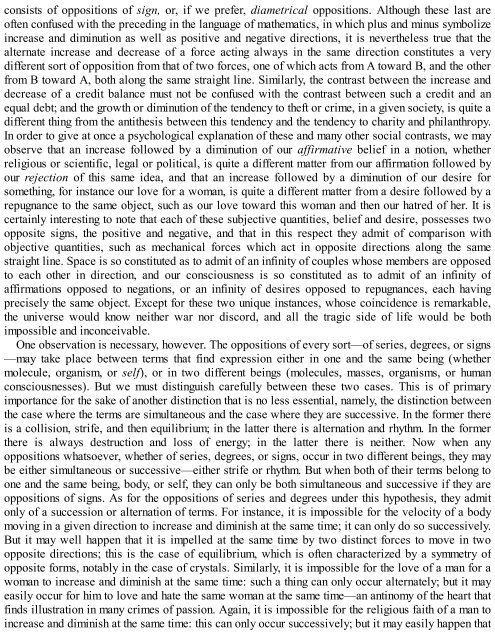3658925934
You also want an ePaper? Increase the reach of your titles
YUMPU automatically turns print PDFs into web optimized ePapers that Google loves.
consists of oppositions of sign, or, if we prefer, diametrical oppositions. Although these last are<br />
often confused with the preceding in the language of mathematics, in which plus and minus symbolize<br />
increase and diminution as well as positive and negative directions, it is nevertheless true that the<br />
alternate increase and decrease of a force acting always in the same direction constitutes a very<br />
different sort of opposition from that of two forces, one of which acts from A toward B, and the other<br />
from B toward A, both along the same straight line. Similarly, the contrast between the increase and<br />
decrease of a credit balance must not be confused with the contrast between such a credit and an<br />
equal debt; and the growth or diminution of the tendency to theft or crime, in a given society, is quite a<br />
different thing from the antithesis between this tendency and the tendency to charity and philanthropy.<br />
In order to give at once a psychological explanation of these and many other social contrasts, we may<br />
observe that an increase followed by a diminution of our affirmative belief in a notion, whether<br />
religious or scientific, legal or political, is quite a different matter from our affirmation followed by<br />
our rejection of this same idea, and that an increase followed by a diminution of our desire for<br />
something, for instance our love for a woman, is quite a different matter from a desire followed by a<br />
repugnance to the same object, such as our love toward this woman and then our hatred of her. It is<br />
certainly interesting to note that each of these subjective quantities, belief and desire, possesses two<br />
opposite signs, the positive and negative, and that in this respect they admit of comparison with<br />
objective quantities, such as mechanical forces which act in opposite directions along the same<br />
straight line. Space is so constituted as to admit of an infinity of couples whose members are opposed<br />
to each other in direction, and our consciousness is so constituted as to admit of an infinity of<br />
affirmations opposed to negations, or an infinity of desires opposed to repugnances, each having<br />
precisely the same object. Except for these two unique instances, whose coincidence is remarkable,<br />
the universe would know neither war nor discord, and all the tragic side of life would be both<br />
impossible and inconceivable.<br />
One observation is necessary, however. The oppositions of every sort—of series, degrees, or signs<br />
—may take place between terms that find expression either in one and the same being (whether<br />
molecule, organism, or self), or in two different beings (molecules, masses, organisms, or human<br />
consciousnesses). But we must distinguish carefully between these two cases. This is of primary<br />
importance for the sake of another distinction that is no less essential, namely, the distinction between<br />
the case where the terms are simultaneous and the case where they are successive. In the former there<br />
is a collision, strife, and then equilibrium; in the latter there is alternation and rhythm. In the former<br />
there is always destruction and loss of energy; in the latter there is neither. Now when any<br />
oppositions whatsoever, whether of series, degrees, or signs, occur in two different beings, they may<br />
be either simultaneous or successive—either strife or rhythm. But when both of their terms belong to<br />
one and the same being, body, or self, they can only be both simultaneous and successive if they are<br />
oppositions of signs. As for the oppositions of series and degrees under this hypothesis, they admit<br />
only of a succession or alternation of terms. For instance, it is impossible for the velocity of a body<br />
moving in a given direction to increase and diminish at the same time; it can only do so successively.<br />
But it may well happen that it is impelled at the same time by two distinct forces to move in two<br />
opposite directions; this is the case of equilibrium, which is often characterized by a symmetry of<br />
opposite forms, notably in the case of crystals. Similarly, it is impossible for the love of a man for a<br />
woman to increase and diminish at the same time: such a thing can only occur alternately; but it may<br />
easily occur for him to love and hate the same woman at the same time—an antinomy of the heart that<br />
finds illustration in many crimes of passion. Again, it is impossible for the religious faith of a man to<br />
increase and diminish at the same time: this can only occur successively; but it may easily happen that









![Genki - An Integrated Course in Elementary Japanese II [Second Edition] (2011), WITH PDF BOOKMARKS!](https://img.yumpu.com/58322134/1/180x260/genki-an-integrated-course-in-elementary-japanese-ii-second-edition-2011-with-pdf-bookmarks.jpg?quality=85)
![Genki - An Integrated Course in Elementary Japanese I [Second Edition] (2011), WITH PDF BOOKMARKS!](https://img.yumpu.com/58322120/1/182x260/genki-an-integrated-course-in-elementary-japanese-i-second-edition-2011-with-pdf-bookmarks.jpg?quality=85)





